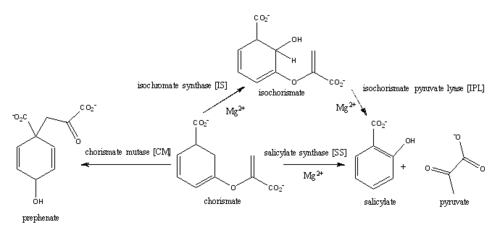Sandbox Reserved 1068
From Proteopedia
| Line 7: | Line 7: | ||
==Introduction== | ==Introduction== | ||
Salicylate synthase from ''Mycobacterim tuberculosis'' (MtbI) is a highly promiscuous enzyme that has four distinct activities ''in vivo'': isochorismate synthase (IS), isochorismate pyruvate lyase (IPL), salicylate synthase (SS) and chromate mutate (CM). MtbI belongs to the chorismate-utilising enzyme family, which consists of structural homologues (<scene name='69/694235/Irp9/1'>Ipr9</scene>, <scene name='69/694235/Menf/1'>MenF</scene>, <scene name='69/694235/Entc/1'>EntC</scene>, and <scene name='69/694235/Mbti/1'>MbtI</scene>) that isomerize chromate to isochorismate. These enzymes are present in bacteria, fungi, plants and apicomplexan parasites and catalyze the initial reactions of menaquinone, siderophore, and tryptophan biosynthesis <ref>PMID:23108268</ref>. | Salicylate synthase from ''Mycobacterim tuberculosis'' (MtbI) is a highly promiscuous enzyme that has four distinct activities ''in vivo'': isochorismate synthase (IS), isochorismate pyruvate lyase (IPL), salicylate synthase (SS) and chromate mutate (CM). MtbI belongs to the chorismate-utilising enzyme family, which consists of structural homologues (<scene name='69/694235/Irp9/1'>Ipr9</scene>, <scene name='69/694235/Menf/1'>MenF</scene>, <scene name='69/694235/Entc/1'>EntC</scene>, and <scene name='69/694235/Mbti/1'>MbtI</scene>) that isomerize chromate to isochorismate. These enzymes are present in bacteria, fungi, plants and apicomplexan parasites and catalyze the initial reactions of menaquinone, siderophore, and tryptophan biosynthesis <ref>PMID:23108268</ref>. | ||
| - | |||
The IS, IPL, and SS activity of MbtI require the presence of a magnesium ion within the active site, while CM activity is only observed in absence of the magnesium cation. IS, IPL, and SS activity are also modulated by the pH of the medium. Isochorismate is the primary product at pH values below 7.5 and salicylate is the primary product formed at pH 8 <ref>PMID:23108268</ref>. The pH dependent activity of MbtI is related to the ionization state of the active site residues involved in the molecular mechanisms used by the enzyme to catalyze the different reactions<ref>PMID:23108268</ref>. | The IS, IPL, and SS activity of MbtI require the presence of a magnesium ion within the active site, while CM activity is only observed in absence of the magnesium cation. IS, IPL, and SS activity are also modulated by the pH of the medium. Isochorismate is the primary product at pH values below 7.5 and salicylate is the primary product formed at pH 8 <ref>PMID:23108268</ref>. The pH dependent activity of MbtI is related to the ionization state of the active site residues involved in the molecular mechanisms used by the enzyme to catalyze the different reactions<ref>PMID:23108268</ref>. | ||
| Line 44: | Line 43: | ||
== Structural highlights == | == Structural highlights == | ||
| - | ==Mechanism== | + | ==Molecular Mechanism== |
| + | '''Isochorismate pyruvae lyase (IPL)''' | ||
| + | For IPL activity, a proposed histidine residue (his334) acts as a base, abstracting the C2 proton of isochorismate through a second order elimination mechanism. The C9 atom of isochorismate is then protonated, leading to the elimination of pyruvate and formation of salicylate. At pH values below 7.5 the histidine residue is protonated and therefore can not act as a base in the mechanism, causing an accumulation of isochorismate. | ||
| + | |||
| + | |||
| + | |||
A magnesium ion in the active site orients the C1 carboxyl group of chorismate. A lysine residue then serves as a general base for the activation of a water molecule to attack at C2 | A magnesium ion in the active site orients the C1 carboxyl group of chorismate. A lysine residue then serves as a general base for the activation of a water molecule to attack at C2 | ||
Revision as of 22:47, 10 April 2015
| This Sandbox is Reserved from 02/09/2015, through 05/31/2016 for use in the course "CH462: Biochemistry 2" taught by Geoffrey C. Hoops at the Butler University. This reservation includes Sandbox Reserved 1051 through Sandbox Reserved 1080. |
To get started:
More help: Help:Editing |
Mycobacterium tuberculosis salicylate synthase (Mbt1)
| |||||||||||
References
1. Chi G1, Manos-Turvey A, O'Connor PD, Johnston JM, Evans GL, Baker EN, Payne RJ, Lott JS, Bulloch EM. 2012. Implications of binding mode and active site flexibility for inhibitor potency against the salicylate synthase from Mycobacterium tuberculosis. Biochemistry 51(24):4868-79. doi: 10.1021/bi3002067
2. Ferrer S1, Martí S, Moliner V, Tuñón I, Bertrán J. 2012 Understanding the different activities of highly promiscuous MbtI by computational methods. Phys Chem Chem Phys. 14(10):3482-9. doi: 10.1039/c2cp23149b.
3. Harrison AJ1, Yu M, Gårdenborg T, Middleditch M, Ramsay RJ, Baker EN, Lott JS. 2006. The structure of MbtI from Mycobacterium tuberculosis, the first enzyme in the biosynthesis of the siderophore mycobactin, reveals it to be a salicylate synthase. J Bacteriol. 188(17):6081-91.
4. Manos-Turvey A1, Cergol KM, Salam NK, Bulloch EM, Chi G, Pang A, Britton WJ, West NP, Baker EN, Lott JS, Payne RJ. 2012. Synthesis and evaluation of M. tuberculosis salicylate synthase (MbtI) inhibitors designed to probe plasticity in the active site. Org Biomol Chem 10(46):9223-36. doi: 10.1039/c2ob26736e.
5. Zwahlen J1, Kolappan S, Zhou R, Kisker C, Tonge PJ. 2007. Structure and mechanism of MbtI, the salicylate synthase from Mycobacterium tuberculosis. Biochemistry. 46(4):954-64.


